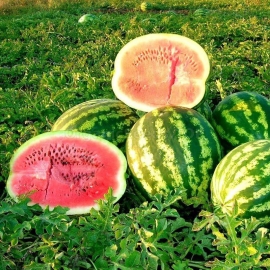



«Stepova 21» - Organic Peavines Seeds
1.14 €
An annual herbaceous plant, the stem of the chin is lodging or straight, 30-50 cm or more high, as a fodder plant, the chin can be used not only for seeds, but also for green mass - in a raw state and as hay.
-
Peavines «Stepova 21»
An annual herbaceous plant from the Legume family. The stem of the tree is lodging or straight, 30-50 cm or more high, glabrous, tetrahedral in shape. The leaves of the plant are pair-pinnate, oblong-lanceolate or lanceolate in shape.
The inflorescence consists of one, or in some cases two relatively large flowers of different colors - yellow, white, pink or blue-lilac. The flowers are located on long stalks. The plant is self-pollinating. The fruit is a two-winged bean with two or more, but not more than five, irregularly shaped seeds. Most often, the seeds are wedge-shaped, resembling a tooth.
Chinna is a relatively undemanding crop for soil. In addition to this rank, it is quite drought-resistant and has high frost resistance. Plant seedlings tolerate short-term frosts down to -6-8°C, which is significantly better than peas and lentils.
The growing season of the plant is about 110-115 days.
It is recommended to use fertilizers with a high content of phosphorus and potassium as fertilizing, since phosphorus accelerates flowering and increases yield, and potassium promotes uniform flowering and more even ripening. Excess nitrogen fertilizer leads to more powerful development of the vegetative mass and uneven ripening of seeds.
Plants are sowed very early in the spring in well-prepared soil in a row method at a distance of approximately 20-30 cm one row from another, it is also possible to sow according to the 50+20 cm pattern (with distances in the row between plants of about 5-6 cm). The seed sowing rate is approximately 13-14 g/m2. The depth of seed placement on light soils is 6-8 cm, on heavy soils - 4-5 cm.
Care consists of regular weeding and loosening; in dry weather, crops need watering. The chins begin harvesting with approximately 75% of the beans turning yellow, leaving them to ripen in windrows, and threshing them. The productivity of chin is quite high - approximately 0.3–0.4 kg/m2.
Usage:
China is distributed primarily as a fodder and industrial crop, but can also be used as a food crop. Chin is richer in proteins than peas, but has poorer taste and takes a long time to boil. As a forage plant, chin can be used not only for seeds, but also for its green mass - in its raw state and as hay. Chin seeds are used as a technical crop to obtain casein.
With this product buy
Product code: 2612
1.14 €
Late (55-65 days) vine heirloom variety. Dark green Cucumbers, 13-18 cm (5-7 in.) long, weight 150-200g (5-7oz.). Plant gives cucumbers until the first frost. Good resistance to all major cucumber diseases.
Product code: 5664
1.14 €
Early maturing variety (65-75 days). Fruits are oval, weight 2-2.5 kg, yellow. The flesh is white, juicy, very sweet and aromatic. The fruit is perfectly transportable over long distances.
Product code: 12064
1.14 €
Medium early, long-climbing, spherical fruit, light green with wide dark green stripes, weighing 2.5-4.5 kg, flesh is carmine-red with a pink tint, grainy, tender, very juicy and sweet, characterized by good transportability.
Product code: 12916
1.14 €
Early ripe variety, Zelenets elongated oval, with a blunt end and intensely colored base, trihedral, often tetrahedral, dark green or green, with longitudinal stripes in the transverse section, the surface of the fruit with small tubercles, ribbed.




